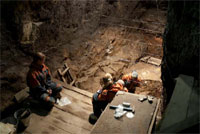Max Planck Institute for Evolutionary Anthropology
The Institute unites scientists with various backgrounds (natural sciences and humanities) whose aim is to investigate the history of humankind from an interdisciplinary perspective with the help of comparative analyses of genes, cultures, cognitive abilities, languages and social systems of past and present human populations as well as those of primates closely related to human beings.
Genome of extinct Siberian human sheds new light on modern human origins.
 The sequencing of the nuclear genome from an ancient finger bone from a Siberian Cave shows that the cave dwellers were neither Neandertals nor modern humans.
The sequencing of the nuclear genome from an ancient finger bone from a Siberian Cave shows that the cave dwellers were neither Neandertals nor modern humans.An international team of researchers led by Svante Pääbo of the Max Planck Institute for Evolutionary Anthropology in Leipzig (Germany) has sequenced the nuclear genome from a finger bone of an extinct hominin that is at least 30,000 years old and was excavated by archaeologists from the Russian Academy of Sciences in Denisova Cave in southern Siberia, Russia, in 2008.
No comments:
Post a Comment
Note: Only a member of this blog may post a comment.